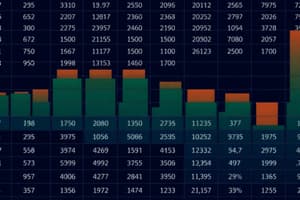Podcast
Questions and Answers
What is a frequency table?
What is a frequency table?
Shows how data are partitioned among several categories by listing the categories along with the number of data values in each.
What is a lower class limit?
What is a lower class limit?
The smallest number that can belong to each of the different classes.
What is an upper class limit?
What is an upper class limit?
The highest number that can belong to each of the different classes.
What is a class boundary?
What is a class boundary?
Find the class boundaries for the frequency distribution: 2 - 8, 9 - 15, 16 - 22.
Find the class boundaries for the frequency distribution: 2 - 8, 9 - 15, 16 - 22.
What is a class midpoint?
What is a class midpoint?
What is class width?
What is class width?
Typically, how many classes are present in a frequency distribution?
Typically, how many classes are present in a frequency distribution?
How do you calculate the appropriate class width for a frequency distribution?
How do you calculate the appropriate class width for a frequency distribution?
What is a relative frequency distribution?
What is a relative frequency distribution?
What is a cumulative frequency distribution?
What is a cumulative frequency distribution?
Flashcards are hidden until you start studying
Study Notes
Frequency Table and Classes
- A frequency table organizes data into categories (classes) and indicates the number of data points (frequency) in each category.
- Lower class limit identifies the smallest value in a class, e.g., for class 75-124, the lower limits are 75 and 125.
- Upper class limit identifies the highest value in a class, complementing the lower limits.
Class Boundaries
- Class boundaries differentiate between classes, ensuring no gaps; calculated as the average of consecutive lower and upper limits.
- For example, boundaries for classes 1-2, 3-4, and 5-6 are 0.5, 2.5, 4.5, and 6.5.
- Example class boundaries from the distribution 2-8, 9-15, 16-22 are 1.5, 8.5, 15.5, and 22.5.
Class Midpoints and Width
- Class midpoint is the average of the lower and upper limits, representing the center of a class.
- Class width is determined by the difference between the lower limits of consecutive classes.
Frequency Distribution Characteristics
- A typical frequency distribution contains between 5 to 20 classes.
- Appropriate class width is calculated as: (maximum data value - minimum data value) / (number of classes), rounded to the nearest whole number, preferably upward.
Types of Frequency Distributions
- Relative Frequency Distribution showcases each class's frequency as a percentage of the total, summing to 100%.
- Cumulative Frequency Distribution tracks the running total of frequencies, illustrating the accumulation of data over classes.
Studying That Suits You
Use AI to generate personalized quizzes and flashcards to suit your learning preferences.




